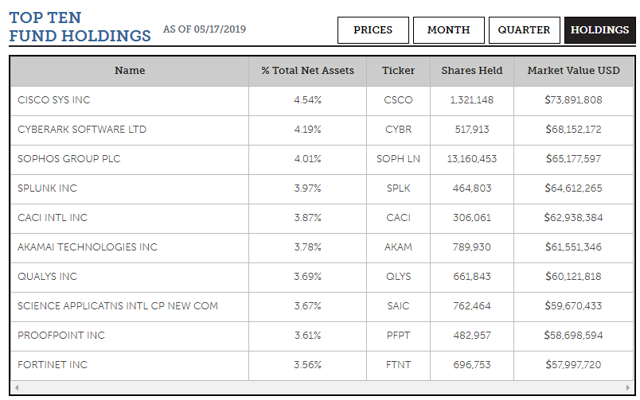[ad_1]
The PureFunds ISE Cyber Security ETF (HACK) is one of the two largest cybersecurity-focused ETFs, the other being the First Trust Nasdaq CEA Cybersecurity ETF (CIBR). Depending on how you want to define “cybersecurity,” these two ETFs are possibly the only two investors have to choose from. We’ll go over what HACK is, the index it follows, and some key differences between it and CIBR.
PureFunds ISE Cyber Security ETF (HACK)
The fund tracks the Prime Cyber Defense Index. The index is constructed so it will be reasonably diversified with individual security weights capped at 4.5%. There are also market cap and trading volume factors designed to eliminate very small, thinly traded securities. The fund has 52 holdings in total.
The one interesting thing about the index is that it appears there is no real quantitative measure for determining if a company qualifies for inclusion. The index states that cybersecurity must be a” vital component” of the company’s business. It would be nice for investors to have some sort of verifiable metric, e.g. 50% of revenue from cybersecurity hardware, software, or consulting work, so they could have a better understanding of what qualifies a company for inclusion in the index. When comparing the fund to CIBR later we’ll see how two different indices can have different takes on what counts as cybersecurity.
So, in some sense, the index functions more along the lines of an active fund with the index committee deciding which stocks to include and which to exclude. The active management type component also helps justify what would be a rather high expense ratio, .60%, for an index fund.
Looking at the fund’s top holdings we don’t really see any surprises.

(Source: Fund website)
There is a variety of network hardware and software companies as well as some government contractors. A little bit less than 90% of the fund’s holdings are based in the US. The fund is also more focused on the commercial market as only 2.83% of the fund is in aerospace and defense stocks (many defense contractors have IT services businesses). There is also a decent number of stocks such as BAH, CACI, LDOS, and SAIC that are focused on IT and professional services.
HACK versus CIBR
The First Trust Nasdaq CEA Cybersecurity ETF (CIBR) is the other major cybersecurity-focused ETF available to investors. Like HACK, the expense ratio is also .6%. The CIBR index tracks the NASDAQ CTA Cybersecurity index. Like the index HACK tracks, there are some limitations in place to exclude small market cap and thinly traded stocks. To be eligible for inclusion a security must be classified by the Consumer Technology Association as a cybersecurity company.

(Graphic source: Fund website)
We see a lot of similarities with HACK. Cisco (CSCO) is the top holding and there is the usual collection of network hardware and software companies along with a mix of IT services companies and defense contractors. Like HACK, CIBR has a bit under 90% of its assets invested in US companies.
However, there appears to be one key difference. CIBR includes more stocks classified as aerospace and defense (again, many defense contractors have good sized IT businesses so this isn’t “wrong” or unusual). Approximately 12% of the fund is in aerospace and defense contractors including traditional weapons systems manufacturers like Raytheon (RTN), BAE Systems (OTCPK:BAESY), and Thales SA (OTCPK:THLEF). By contrast, HACK’s only weapons system manufacturer is a .76% position in BAE Systems.
Summary
Given how similar both funds are, it’s no surprise that performance has been almost identical. The average annual return for the past three years (as of 4/30/2019) for HACK has been 21.05% while for CIBR it was 20.89%.
The only real, substantial difference between the two funds seems to be whether or not to include many aerospace and defense firms. There is no right or wrong answer here in our opinion given that many defense contractors have substantial IT and cybersecurity businesses. Investors should simply pick which fund suits their preference. If you are someone who holds both CIBR and an aerospace and defense ETF in your portfolio just be aware that you will have about a 12% overlap between the holdings of the two funds.
Disclosure: I am/we are long RTN. I wrote this article myself, and it expresses my own opinions. I am not receiving compensation for it (other than from Seeking Alpha). I have no business relationship with any company whose stock is mentioned in this article.
[ad_2]
Source link Google News

